Table of Contents
Overview……………………………………………………………..…4
Document Flow……………………………………………………..…5
Encumbrances………………………………………………………...6
What is a Requisition?…………………………………………….…7
Functions……….……………………………………………..………..8
Enter Requisitions……………………………….…………………….9
Enter Requisitions 9
Drop-Down Menus 10
Navigation Buttons 10
Action Buttons 11
Fields and Descriptions 11
Adding a Requisition Record 12
Updating a Requisition Record 12
Deleting a Requisition Record 13
Submitting a Requisition 13
Item Entry……………………………………………………………….14
Fields and Descriptions 14
Adding a Requisition Item Record 16
Updating a Requisition Item Record 16
Deleting a Requisition Item Record 16
Submitting a Requisition Item Record 17
Action Buttons 17
Shipping……………………………………………………………..…19
To Add or Update Shipping: 19
Deleting a Shipping Record 20
Action Buttons 20
Percent Distribution………………………………………………….22
To Add or Update Distribution Records: 22
Deleting a Distribution Record 23
Action Buttons 23
Resubmit Requisitions 24
Drop-Down Menus 24
Navigation Buttons 25
Action Buttons 25
Fields and Descriptions 26
Updating a Requisition Record 27
Deleting a Requisition Record 27
Resubmitting a Requisition 27
Item Entry………………………………………………………………..29
Fields and Descriptions 29
Adding a Requisition Item Record 31
Updating a Requisition Item Record 31
Deleting a Requisition Item Record 31
Submitting a Requisition Item Record 32
Actions Buttons 32
Shipping……………………………………………………….……….33
To Add or Update Shipping: 33
Deleting a Shipping Record 34
Action Buttons 34
Percent Distribution 35
To Add or Update Distribution Records: 35
Deleting a Distribution Record 36
Action Buttons 36
Level One………………………………………………………………..37
Approve Requisitions 37
Requisition Browser 37
Requisition Line Items 38
Item Description 38
Drop-Down Menus 38
Navigation Buttons 39
Action Buttons 39
Approve 40
Disapprove 40
Level Two………………………………………………………………..43
Approve Requisitions 43
Requisition Browser 43
Requisition Line Items 44
Item Description 442
Drop-Down Menus 44
Navigation Buttons 45
Action Buttons 45
Approve 46
Disapprove 46
Level Three …………………………………………………………….47
Approve Requisitions 45
Requisition Browser 45
Requisition Line Items 48
Item Description 48
Drop-Down Menus 48
Navigation Buttons 49
Action Buttons 49
Approve 48
Disapprove 48
Business Office 49
Approve Requisitions 49
Requisition Browser 49
Requisition Line Items 52
Item Description 52
Drop-Down Menus 52
Navigation Buttons 53
Action Buttons 53
Approve 54
Disapprove 54
Create Purchase Orders 53
Open Purchase Order Schedule Browser 55
Requisitions 56
Drop-Down Menus 56
Navigation Buttons 56
Action Buttons 57
Create PO 57
Account Status 58
Drop-Down Menus 58
Navigation Buttons 59
To Generate the Account Status Report: 59
Set up Approval Process Parameters 59
Requisition Approval Maintenance 59
Selecting a Sort Option 59
Drop-Down Menus 60
Navigation Buttons 62
Fields and Descriptions 63
Adding a User Approval Record 64
Updating a User Approval Record 64
Deleting a User Approval Record 64
Overview
REQUISITION MANAGER is the user-friendly, requisition module of the FINANCE MANAGER SERIES of Interactive Fund Accounting Software. It features built-in controls to eliminate invalid data entry and over-expenditure problems. It has been developed specifically to deal with special accounting issues that face municipal entities.
REQUISITION MANAGER allows for the entry of purchase requisitions electronically into the system. Once entered, the requisition is electronically approved by up to three levels of administrators before reaching the business office. At the business office, the requisition is used to create a printed purchase order. The printed purchase order is then sent to the vendor to start the purchasing process.
In addition to the entry of electronic purchase requisitions, REQUISITION MANAGER allows the users to obtain up-to-the-minute reports in both summary and detail of their individual appropriation budget codes.
But before becoming involved in the details of the REQUISITION MANAGER, the user must grasp the three most important concepts of the program:
· Understanding the document flow of requisitions
· What is an Encumbrance?
· Maneuvering through the program
The operation of REQUISITION MANAGER is based on the process of preparing formal requisitions on a preprinted form, having them signed by the proper authorized employees, and then forwarding them to the business official for final approval and issuance as purchase orders.
The requisition document must flow through a series of people- from the originator of the requisition, to authorized employee number one, to authorized employee number two, to authorized employee number three and finally the business office.
To fully exploit the power of REQUISITION MANAGER, each document flow must be defined for each user. Electronically, each user will be defined by the employees who receive their requisitions for approval. Once defined, the electronic requisitions will properly flow from user to supervisor to the business office.
A Definition
Encumbrances are the temporary accounting entries used in fund accounting systems to reserve budgeted funds for a specific, designated purpose.
Where Encumbrances Come From
In general, most encumbrances are generated from Purchase Orders, official purchase agreements issued by a municipal agency to agree to purchase the indicated goods, supplies, or services from the noted vendor. The purchase order details the specific items to be purchased, the item cost and quantity, and the total shipping costs to be incurred by the municipal entity.
Benefits to the Vendor
The purchase order ensures to the vendor that the agency’s purchasing agent has properly authorized the purchase. The document also provides an assurance to the vendor that payment will be made for the purchase, eliminating the need for the vendor to secure detailed credit reports on the municipal entity. The document also defines the shipping address, contact person, and any additional shipping requirements that may be required by the municipal entity.
Benefits to the Municipal Entity
The purchase order also provides the municipal entity with budgetary and purchasing control features.
The purchase order serves as a temporary accounting entry which encumbers funds for the specific purchase. The encumbering—setting enough money aside from general expenses for the purchase—lasts until the ordered goods are delivered and the original invoice is presented for payment. When the goods have been delivered and billed for, the encumbrance is removed—known as being liquidated—and those funds reserved by the encumbrance are used to pay the invoice.
Purchasing controls are created by the purchase order. The creation of a standard purchase order ensures that an authorized and approved user is making the purchase. The purchase order also enables the municipal entity to track the account codes being used to ensure an account code is not overspent.
Requisitions are formal purchasing requests that have not yet been approved and authorized by the central business office. The requisition uses the same budgetary account code and vendor information used by ACCOUNTING MANAGER in preparing standard accounting entries.
Requisitions may be approved by other administrators before being submitted to the business office. Once approved by the business office, the requisition is made into a formal purchase order. The printed and authorized purchase order is issued to the vendor to begin the purchasing cycle.
The REQUISITION MANAGER program can be broken up into five different sections or functions. Each function has its own specific purpose in the program. Similar operations have been grouped together to simplify REQUISITION MANAGER’s operation.
The five functions consist of routines for:
| Data Entry | All data to be entered into REQUISITION MANAGER is input through the Data Entry module. All Requisitions are entered through this process. |
| Approval Process | The approval process steps allow each requisition to be approved at each level of the purchasing process. |
| Query | The query function allows the user to search for information for a specific data item or items, such as an individual appropriation code or an individual requisition. The user can define the search criteria to customize the search or select the built-in defaults and query all data entries. |
| Reports | The reports function provides a variety of standard reports that the user may either display or printout. Output includes appropriation status reports and individual account code transactions reports |
| Utilities | The utilities function allows the system administrator to define certain system parameters and permissions. The user may define parameters or use the default parameters. |
The data entry module of REQUISITION MANAGER enables users to enter and resubmit individual purchase requisitions for electronic processing into purchase orders. To enter the Enter Requisitions module, select Data Entry from the main menu and then select Enter Requisitions.
Parts of the Requisition
Each requisition has four parts. The first part is the information part of the requisition, which records the date, the vendor, the building or location of delivery, and a brief description. The second part is the item entry screen, which records the appropriation account if all items are from the same account, the quantity, the unit of measure, the cost of each item, discount and shipping information. The third part is the shipping screen for the breakdown of the shipping percentage for each account. The fourth part is the percent distribution screen, which records the breakdown of payment for each account.
Enter Requisitions
To access the Remote Requisition Entry function, select the Enter Requisitions option from the Data Entry drop-down menu or simply select the EnterReq button ![]() on the Requisition Manager main window.
on the Requisition Manager main window.
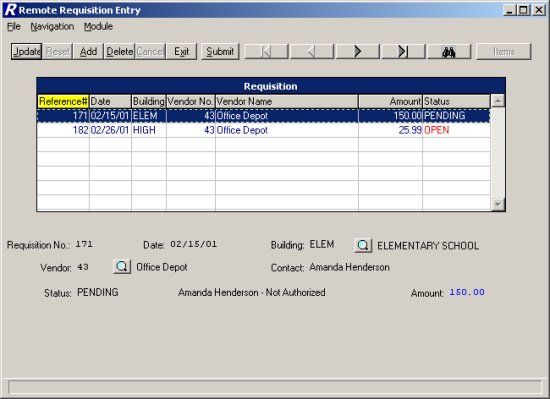
The Remote Requisition Entry window displays a list of those requisitions that were entered by the user logged into the system and that have not yet been approved by any other user. The window displays the requisition reference number, date, building, vendor information, amount, and status. The information in the browser is sorted in numerical ascending order by reference number.
Use this function to add or maintain requisition line items and account distribution entries. In addition, this function is used to flag those requisitions that need to be approved.
Drop-Down Menus
The following drop-down menus are displayed on the window:
File This menu provides access to the Exit option which allows you to exit the function. The menu also allows you to submit a selected requisition for approval.
Navigation This menu provides access to the First, Previous, Next, Last, and Search options that allow you to locate specific records in the browser.
Module This menu provides access to the Item Entry and Requisition windows.
The navigation options can be accessed through the buttons at the top of the window or through the Navigation drop-down menu.
| Navigation Button |
Function |
| First |
This option is used to highlight the first record in the browser. |
| Previous |
This option is used to highlight the previous record in the browser. For example, if there are five records in the browser and your cursor is highlighting the third record, select the Previous button to highlight the previous (second) record. |
| Next |
This option is used to highlight the next record in the browser. For example, if there are five records in the browser and your cursor is highlighting the third record, select the Next button to highlight the next (fourth) record. |
Last
|
This option is used to highlight the last record in the browser. |
| Search |
This option is used to search for a specific record. Select this option to display the Search field. Key in the requisition reference number and press Enter or Tab to exit the search field. The system highlights the requisition record or the closest match to the number entered. |
| Action Button |
Function |
|
Submit |
This option is used to submit a selected requisition for approval. |
|
Items |
This option is used to display the items associated with the selected requisition. |
|
Exit |
This option is used to exit the Requisition Entry function. If any open (unsubmitted) requisitions exist, the system displays a message indicating so. |
Use the Enter Requisition function to add or maintain requisitions.
| Field | Description |
| Requisition No. | The number that uniquely references the requisition. When adding a requisition, this field defaults to the next sequential requisition number. The default value is not modifiable. |
| Date | The date (in MM/DD/YY format) that the requisition is being entered into the system. This field defaults to the current date. You may change the default value as needed. |
| Building | The code representing the building where the requested items are to be delivered. Use the lookup button to display and choose from a listing of valid building codes from the Building Code Maintenance File. |
| Vendor | (Required) The number that uniquely identifies the vendor to whom the purchase order is to be sent. Use the lookup button to display and choose from a listing of valid vendor codes from the Vendor Code Maintenance File. |
| Contact | This field defaults to the name of the user who is logged into the system. You may change the default contact name as needed. The contact name is displayed on the printed requisition. |
| Status | This system-generated field reflects the current status of the requisition. The requisition is in an OPEN status when it is first created. Once the requisition has been submitted for approval, the status is changed to PENDING. |
| Amount | This system-calculated field reflects the total amount of the requisition line items plus any overall shipping charges. |
Adding a Requisition Record
· Select the Add button.
· Enter the date, building, vendor, and contact person.
· Press Save to lock in the new information.
The system automatically places you in Add mode on the Item Entry window.
Updating a Requisition Record
· Highlight the appropriate requisition record in the browser. The navigation button options and/or browser scroll bar will assist you in finding the desired record.
· Select the Update button.
· Modify the requisition information as needed.
· Press Save to lock in the new information.
Deleting a Requisition Record
This option is used to delete a requisition record that contains no line items. If line items exist for the selected requisition, deletion is not allowed until all line items are removed.
· Highlight the appropriate requisition record in the browser. The navigation button options and/or browser scroll bar will assist you in finding the desired record.
· Select the Delete button.
·
The system prompts you to confirm that this is the correct action that you wish to take.
Enter YES to delete the requisition record.
Enter NO if you do not wish to delete the requisition record.
The requisition status is changed from Open to Pending and the requisition is submitted to the first approver or the Business Office.
The Item Entry window is used to add and maintain the line items associated with the requisition.
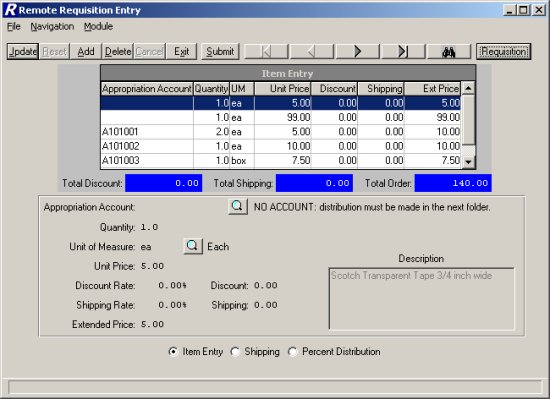
The middle portion of the window provides the following running totals:
Total Discount – The sum of the discounts of all requisition line items.
Total Shipping – The sum of the shipping charges associated with each individual requisition line item.
Total Order – The sum of the extended prices of all requisition line items.
| Field | Description |
| Appropriation Account | The number that identifies the appropriation account from the Chart of Accounts File to which the requisition item is being expensed. Use the lookup button to display and choose from a listing of valid appropriation codes linked to the user as defined in the User Account Chart Links function.
NOTE: If the requisition line item is being expensed out of more than one appropriation account, leave this field blank. The system displays the message "NO ACCOUNT: Distribution must be made in the next folder." Use the Percent Distribution window to expense the line item to the appropriate accounts. |
| Quantity | Enter the quantity of the item being requisitioned. |
| Unit of Measure | The code representing the unit of measure (each, box, dozen) of the item being requisitioned. Use the lookup button to display and choose from a listing of valid unit of measure codes from the Unit of Measure Code Maintenance File. |
| Unit Price | Enter the price per unit of measure of the item being requisitioned. |
| Description | Enter a free-text description of the item being requisitioned. |
| Discount Rate | (Optional) Enter the discount percentage rate for the item being requisitioned. If the discount percentage is entered, the system will automatically calculate the appropriate discount amount.
NOTE: If a discount percentage is specified for the vendor on the Profile folder in Vendor Maintenance, that vendor discount percentage defaults in the Discount Rate field. |
| Discount | (Optional) Enter the discount amount applicable to the item being requisitioned. This amount will already be calculated if a Discount Rate has been entered, but can still be modified. |
| Shipping Rate | (Optional) Enter the shipping percentage rate for the item being requisitioned. If the shipping percentage is entered, the system will automatically calculate the appropriate shipping amount.
NOTE: If a shipping charge is applicable to all items in the entire requisition, use the Shipping window to indicate the overall shipping charge and the account codes to which the shipping is to be expensed. |
| Shipping | (Optional) Enter the shipping amount applicable to the item being requisitioned. This amount will already be calculated if a Shipping Rate has been entered, but can still be modified. |
| Extended Price | This system-calculated field is determined by the following formula:
(Quantity X Unit Price) minus Discount plus Shipping. |
Adding a Requisition Item Record
· Select the Add button.
· Enter the appropriate item information.
· Press Save to lock in the new information.
Updating a Requisition Item Record
· Highlight the appropriate requisition line item record in the browser. The browser scroll bar will assist you in finding the desired record.
· Select the Update button.
· Modify the item information as needed.
· Press Save to lock in the new information.
Deleting a Requisition Item Record
This option is used to delete a line item from the requisition record.
NOTE: If you used the Percent Distribution window to expense money from multiple accounts, you must remember to delete those account distribution records in order to be able to exit from the Enter Requisitions function.
·
Highlight the appropriate line item in the browser. The browser scroll bar will assist you in finding the desired record.
·
Select the Delete button.
·
The system prompts you to confirm that this is the correct action that you wish to take.
Enter YES to delete the line item record.
Enter NO if you do not wish to delete the line item record.
| Action Button |
Function |
|
Submit |
This option is used to submit the selected requisition for approval. |
|
Requisition |
This option is used to display the requisition window that contains your requisitions. |
|
Item Entry |
This option is used to display the requisition line item entry window. |
|
Shipping |
This option is used to display the Shipping window where you can indicate the overall shipping charge for all items in the requisition and the account codes to which the shipping is to be expensed. |
|
Percent Distribution |
This option is used to display the Percent Distribution window. If the requisition line item is being expensed out of more than one appropriation account, use the Percent Distribution window to expense the line item to the appropriate accounts. |
|
Exit |
This option is used to exit the Requisition Entry function. If any open (unsubmitted) requisitions exist, the system displays a message indicating so. |
The Shipping window is accessed by selecting the Shipping radio button from the Item Entry or Percent Distribution window. The Shipping window is used to add and maintain the overall shipping charge for all items in the requisition and the account codes to which the shipping is to be expensed.
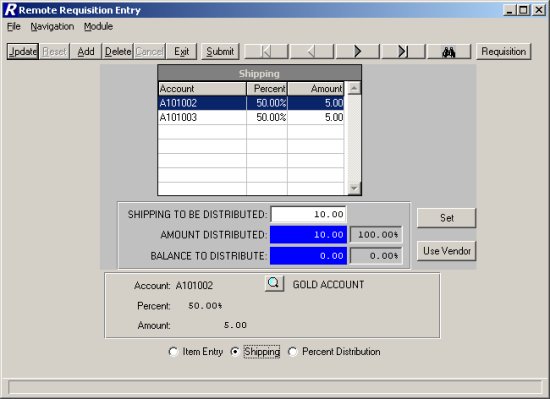
To Add or Update Shipping:
1. Indicate the overall shipping amount for the entire requisition in the Shipping To Be Distributed field. Press the Set button.
OR
Select the Use Vendor button to use the vendor default shipping amount as defined in the Vendor Maintenance File. If a shipping charge is specified for the vendor on the Profile folder in Vendor Maintenance, that vendor shipping amount defaults in the Shipping To Be Distributed field.
The system calculates the Balance to Distribute.
2. Select the Add (or Update) button.
3. Enter the appropriate account code from which the shipping charges are to be expensed. Use the lookup button to display and choose from a listing of valid account codes linked to the user as defined in the User Account Chart Links function.
4. Enter the percentage of the shipping charges to be expensed from the selected account.
The system automatically calculates the Amount based on the overall shipping amount and the percentage indicated.
5. Enter the amount of the shipping.
6. Press Save to save the record.
Continue to repeat steps 2 through 6 until the entire shipping amount has been expensed to the appropriate accounts.
| Action Button |
Function |
|
Submit |
This option is used to submit the selected requisition for approval. Press the Submit button. The requisition status is changed from Open to Pending and the requisition is submitted to the first approver. |
|
Requisition |
This option is used to display the requisition window that contains your requisitions. |
|
Item Entry |
This option is used to display the requisition line item entry window. |
|
Percent Distribution |
This option is used to display the Percent Distribution window. If the requisition line item is being expensed out of more than one appropriation account, use the Percent Distribution window to expense the line item to the appropriate accounts. |
|
Exit |
This option is used to exit the Requisition Entry function. If any open (unsubmitted) requisitions exist, the system displays a message indicating so. |
The Percent Distribution window is accessed by selecting the Percent Distribution radio button from the Item Entry or Shipping window. The Percent Distribution window is used when a requisition line item(s) is being expensed out of more than one appropriation account. The system totals the extended price of those requisition detail line items where the Appropriation Account field was left blank on the Item Entry window. That amount must then be distributed to the appropriate account codes prior to submitting the requisition or exiting the Enter Requisition function.
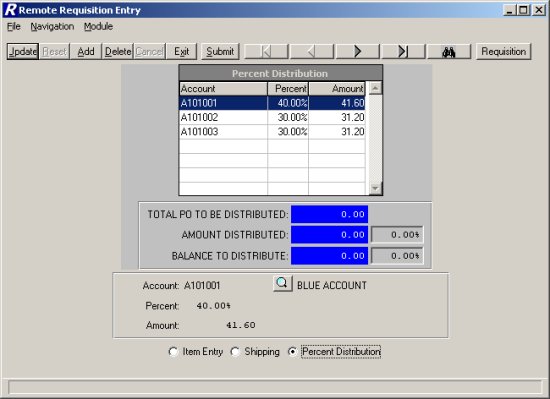
To Add or Update Distribution Records:
The system displays the undistributed portion of the requisition in the Total PO To Be Distributed field. The Amount Distributed and Balance to Distribute fields are recalculated each time a record is added, updated, or deleted.
1. Select the Add (or Update) button.
2. Enter the appropriate account code from which the item charges are to be expensed. Use the lookup button to display and choose from a listing of valid account codes linked to the user as defined in the User Account Chart Links function.
3. Enter the percentage of the item charges to be expensed from the selected account.
The system automatically calculates the Amount based on the Total PO Amount to be Distributed.
4. Enter the amount to be expensed to the selected account.
5. Press Save to save the record.
Continue to repeat steps 1 through 5 until the entire requisition amount has been distributed to the appropriate accounts.
Deleting a Distribution Record
· Highlight the appropriate line item in the browser. The browser scroll bar will assist you in finding the desired record.
· Select the Delete button.
| Action Button |
Function |
|
Submit |
This option is used to submit the selected requisition for approval. Press the Submit button. The requisition status is changed from Open to Pending and the requisition is submitted to the first approver. |
|
Requisition |
This option is used to display the requisition window that contains your requisitions. |
|
Item Entry |
This option is used to display the requisition line item entry window. |
|
Shipping |
This option is used to display the Shipping window where you can indicate the overall shipping charge for all items in the requisition and the account codes to which the shipping is to be expensed. |
|
Exit |
This option is used to exit the Requisition Entry function. If any open (unsubmitted) requisitions exist, the system displays a message indicating so. |
To access the Resubmit Requisition Entry function, select the Resubmit Requisition option from the Data Entry drop-down menu or simply select the Re-Submit button ![]() on the Requisition Manager main window.
on the Requisition Manager main window.

The Resubmit Requisition Entry window displays a list of those requisitions that were entered by the user logged into the system and were disapproved. The window displays the requisition reference number, date, building, vendor information, amount, and status. The information in the browser is sorted in numerical ascending order by reference number.
Use this function to modify or delete requisition line items and account distribution entries. In addition, this function is used to flag those requisitions that need to be approved.
Drop-Down Menus
The following drop-down menus are displayed on the window:
File This menu provides access to the Exit option that allows you to exit the function. The menu also allows you to resubmit a selected requisition for approval.
Navigation This menu provides access to the First, Previous, Next, Last, and Search options that allow you to locate specific records in the browser.
Module This menu provides access to the Item Entry and Requisition windows.
The navigation options can be accessed through the buttons at the top of the window or through the Navigation drop-down menu.
| Navigation Button |
Function |
| First |
This option is used to highlight the first record in the browser. |
| Previous |
This option is used to highlight the previous record in the browser. For example, if there are five records in the browser and your cursor is highlighting the third record, select the Previous button to highlight the previous (second) record. |
| Next |
This option is used to highlight the next record in the browser. For example, if there are five records in the browser and your cursor is highlighting the third record, select the Next button to highlight the next (fourth) record. |
Last
|
This option is used to highlight the last record in the browser. |
| Search |
This option is used to search for a specific record. Select this option to display the Search field. Key in the requisition reference number and press Enter or Tab to exit the search field. The system highlights the requisition record or the closest match to the number entered. |
| Action Button |
Function |
|
Submit |
This option is used to resubmit a selected requisition for approval. |
|
Items |
This option is used to display the items associated with the selected requisition. |
|
Exit |
This option is used to exit the Resubmit Requisition Entry function. |
Use the Resubmit Requisition Entry function to update or delete unapproved requisitions and/or requisition line items and account distribution entries.
| Field | Description |
| Requisition No. | The number that uniquely references the requisition. This number is system-assigned and is not modifiable. |
| Date | The date (in MM/DD/YY format) that the requisition is being entered into the system. |
| Building | The code representing the building where the requested items are to be delivered. Use the lookup button to display and choose from a listing of valid building codes from the Building Code Maintenance File. |
| Vendor | (Required) The number that uniquely identifies the vendor to whom the purchase order is to be sent. Use the lookup button to display and choose from a listing of valid vendor codes from the Vendor Code Maintenance File. |
| Contact | The contact name as displayed on the printed requisition. |
| Status | This system-generated field reflects the current status of the requisition. Once the requisition has been disapproved, the status is DISAPPROVED. The reason for the disapproval is also displayed. |
| Amount | This system-calculated field reflects the total amount of the requisition line items plus any overall shipping charges. |
Updating a Requisition Record
· Highlight the appropriate requisition record in the browser. The navigation button options and/or browser scroll bar will assist you in finding the desired record.
· Select the Update button.
· Modify the requisition information as needed.
· Press Save to lock in the new information.
Deleting a Requisition Record
This option is used to delete a requisition record that contains no line items. If line items exist for the selected requisition, deletion is not allowed until all line items are removed.
· Highlight the appropriate requisition record in the browser. The navigation button options and/or browser scroll bar will assist you in finding the desired record.
· Select the Delete button.
·
The system prompts you to confirm that this is the correct action that you wish to take.
Enter YES to delete the requisition record.
Enter NO if you do not wish to delete the requisition record.
The requisition is removed from the Resubmit window and the status is changed from Disapproved to Pending. The requisition can be displayed on the Requisition window in the Enter Requisition function and the requisition is submitted to the first approver or the Business Office.
The Item Entry window is used to add and maintain the line items associated with the requisition.
The middle portion of the window provides the following running totals:
Total Discount – The sum of the discounts of all requisition line items.
Total Shipping – The sum of the shipping charges associated with each individual requisition line item.
Total Order – The sum of the extended prices of all requisition line items.
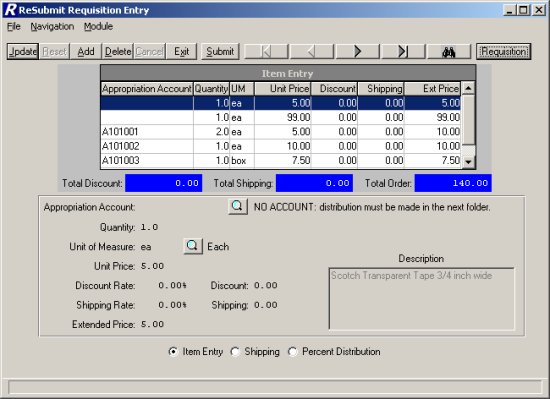
| Field | Description |
| Appropriation Account | The number that identifies the appropriation account from the Chart of Accounts File to which the requisition item is being expensed. Use the lookup button to display and choose from a listing of valid appropriation codes linked to the user as defined in the User Account Chart Links function.
NOTE: If the requisition line item is being expensed out of more than one appropriation account, leave this field blank. The system displays the message "NO ACCOUNT: Distribution must be made in the next folder." Use the Percent Distribution window to expense the line item to the appropriate accounts. |
| Quantity | Enter the quantity of the item being requisitioned. |
| Unit of Measure | The code representing the unit of measure (each, box, dozen) of the item being requisitioned. Use the lookup button to display and choose from a listing of valid unit of measure codes from the Unit of Measure Code Maintenance File. |
| Unit Price | Enter the price per unit of measure of the item being requisitioned. |
| Description | Enter a free-text description of the item being requisitioned. |
| Discount Rate | (Optional) Enter the discount percentage rate for the item being requisitioned. If the discount percentage is entered, the system will automatically calculate the appropriate discount amount.
NOTE: If a discount percentage is specified for the vendor on the Profile folder in Vendor Maintenance, that vendor discount percentage defaults in the Discount Rate field. |
| Discount | (Optional) Enter the discount amount applicable to the item being requisitioned. This amount will already be calculated if a Discount Rate has been entered, but can still be modified. |
| Shipping Rate | (Optional) Enter the shipping percentage rate for the item being requisitioned. If the shipping percentage is entered, the system will automatically calculate the appropriate shipping amount.
NOTE: If a shipping charge is applicable to all items in the entire requisition, use the Shipping window to indicate the overall shipping charge and the account codes to which the shipping is to be expensed. |
| Shipping | (Optional) Enter the shipping amount applicable to the item being requisitioned. This amount will already be calculated if a Shipping Rate has been entered, but can still be modified. |
| Extended Price | This system-calculated field is determined by the following formula:
(Quantity X Unit Price) minus Discount plus Shipping. |
Adding a Requisition Item Record
· Select the Add button.
· Enter the appropriate item information.
· Press Save to lock in the new information.
Updating a Requisition Item Record
· Highlight the appropriate requisition line item record in the browser. The browser scroll bar will assist you in finding the desired record.
· Select the Update button.
· Modify the item information as needed.
· Press Save to lock in the new information.
Deleting a Requisition Item Record
This option is used to delete a line item from the requisition record.
NOTE: If you used the Percent Distribution window to expense money from multiple accounts, you must remember to delete those account distribution records in order to be able to exit from the Enter Requisitions function.
·
Highlight the appropriate line item in the browser. The browser scroll bar will assist you in finding the desired record.
·
Select the Delete button.
·
The system prompts you to confirm that this is the correct action that you wish to take.
Enter YES to delete the line item record.
Enter NO if you do not wish to delete the line item record.
| Action Button |
Function |
|
Submit |
This option is used to resubmit the selected requisition for approval. |
|
Requisition |
This option is used to display the requisition window that contains your requisitions that were disapproved. |
|
Item Entry |
This option is used to display the requisition line item entry window. |
|
Shipping |
This option is used to display the Shipping window where you can indicate the overall shipping charge for all items in the requisition and the account codes to which the shipping is to be expensed. |
|
Percent Distribution |
This option is used to display the Percent Distribution window. If the requisition line item is being expensed out of more than one appropriation account, use the Percent Distribution window to expense the line item to the appropriate accounts. |
|
Exit |
This option is used to exit the Resubmit Requisition Entry function. |
The Shipping window is accessed by selecting the Shipping radio button from the Item Entry or Percent Distribution window. The Shipping window is used to add and maintain the overall shipping charge for all items in the requisition and the account codes to which the shipping is to be expensed.
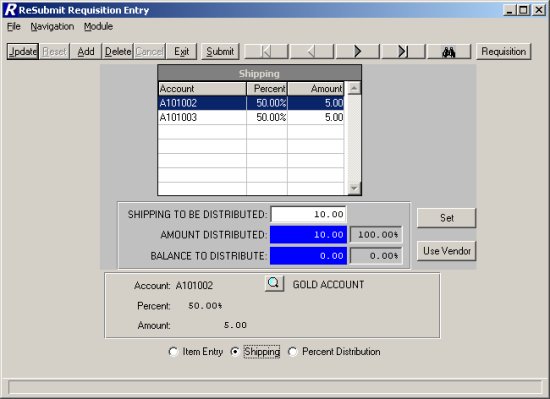
To Add or Update Shipping:
1. Indicate the overall shipping amount for the entire requisition in the Shipping To Be Distributed field. Press the Set button.
OR
Select the Use Vendor button to use the vendor default shipping amount as defined in the Vendor Maintenance File. If a shipping charge is specified for the vendor on the Profile folder in Vendor Maintenance, that vendor shipping amount defaults in the Shipping To Be Distributed field.
The system calculates the Balance to Distribute.
2. Select the Add (or Update) button.
3. Enter the appropriate account code from which the shipping charges are to be expensed. Use the lookup button to display and choose from a listing of valid account codes linked to the user as defined in the User Account Chart Links function.
4. Enter the percentage of the shipping charges to be expensed from the selected account.
The system automatically calculates the Amount based on the overall shipping amount and the percentage indicated.
5. Enter the amount of the shipping.
6. Press Save to save the record.
Continue to repeat steps 2 through 6 until the entire shipping amount has been expensed to the appropriate accounts.
| Action Button |
Function |
|
Submit |
This option is used to resubmit the selected requisition for approval. Press the Submit button. The requisition status is changed from Disapproved to Pending and the requisition is submitted to the first approver or the Business Office. |
|
Requisition |
This option is used to display the requisition window that contains your requisitions that were disapproved. |
|
Item Entry |
This option is used to display the requisition line item entry window. |
|
Percent Distribution |
This option is used to display the Percent Distribution window. If the requisition line item is being expensed out of more than one appropriation account, use the Percent Distribution window to expense the line item to the appropriate accounts. |
|
Exit |
This option is used to exit the Resubmit Requisition Entry function. |
The Percent Distribution window is accessed by selecting the Percent Distribution radio button from the Item Entry or Shipping window. The Percent Distribution window is used when a requisition line item(s) is being expensed out of more than one appropriation account. The system totals the extended price of those requisition detail line items where the Appropriation Account field was left blank on the Item Entry window. That amount must then be distributed to the appropriate account codes prior to submitting the requisition or exiting the Resubmit Requisition Entry function.
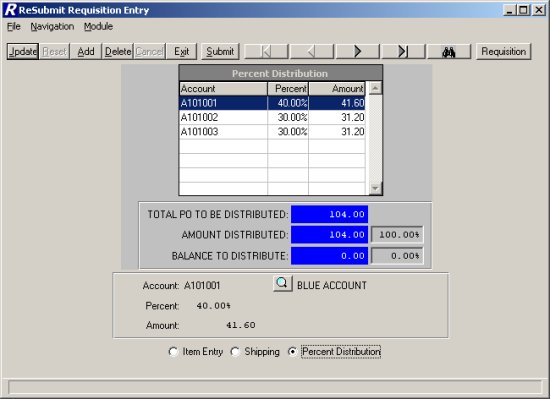
To Add or Update Distribution Records:
The system displays the undistributed portion of the requisition in the Total PO To Be Distributed field. The Amount Distributed and Balance to Distribute fields are recalculated each time a record is added, updated, or deleted.
1. Select the Add (or Update) button.
2. Enter the appropriate account code from which the item charges are to be expensed. Use the lookup button to display and choose from a listing of valid account codes linked to the user as defined in the User Account Chart Links function.
3. Enter the percentage of the item charges to be expensed from the selected account.
The system automatically calculates the Amount based on the Total PO Amount to be Distributed.
4. Enter the amount to be expensed to the selected account.
5. Press Save to save the record.
Continue to repeat steps 1 through 5 until the entire requisition amount has been distributed to the appropriate accounts.
Deleting a Distribution Record
· Highlight the appropriate line item in the browser. The browser scroll bar will assist you in finding the desired record.
· Select the Delete button.
| Action Button |
Function |
|
Submit |
This option is used to resubmit the selected requisition for approval. Press the Submit button. The requisition status is changed from Disapproved to Pending and the requisition is submitted to the first approver or the Business Office. |
|
Requisition |
This option is used to display the requisition window that contains your requisitions that were disapproved. |
|
Item Entry |
This option is used to display the requisition line item entry window. |
|
Shipping |
This option is used to display the Shipping window where you can indicate the overall shipping charge for all items in the requisition and the account codes to which the shipping is to be expensed. |
|
Exit |
This option is used to exit the Resubmit Requisition Entry function. |
Approve Requisitions
To access the Approve Requisitions function, select the Level One option from the Approval Process drop-down menu or simply select the Level 1 button on the Requisition Manager main window. The Level 1 button is active based on the authorization level defined for the approver in the Setup Approval Process Parameters function. In addition, the "RQ – Approval Level" permissions defined for the user in User Maintenance must also be set to YES.
Use the Approve Requisition function to approve or disapprove those requisitions that are currently in a Pending status.
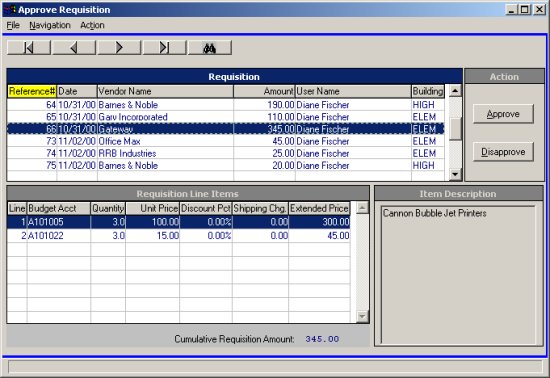
Requisition Browser
The Requisition browser at the top of the window displays those requisitions that are pending approval or disapproval. The information in the browser can be sorted in any of the following ways:
numerically by requisition reference number,
from earliest to most recent requisition date,
alphabetically by vendor name,
from smallest to highest requisition amount,
alphabetically by requisitioner name,
alphabetically by building code.
To change the manner in which information is displayed in the browser, simply click on the column title (Reference #, Date, Vendor Name, Amount, User Name, or Building). The column title is highlighted in yellow to indicate the selected sort option. Use this browser to select the appropriate requisition record.
Requisition Line Items
Based on the record selected in the Requisition browser, the system displays the associated detail requisition line items on the bottom left-hand side of the window. The detail record includes the following information: number of line items in the requisition, account number to which the item is being expensed, quantity ordered, unit price per unit of measurement ordered, discount percent, shipping charge and extended price. The Cumulative Requisition Amount is also provided. Use this browser to select and view a specific requisition line item.
Item Description
Based on the record selected in the Requisition Line Items browser, the system displays the detailed item description as entered during the Requisition Entry process.
Drop-Down Menus
The following drop-down menus are displayed on the window:
File This menu provides access to the Exit option that allows you to exit the function.
Navigation This menu provides access to the First, Previous, Next, Last, and Search options that allow you to locate specific records in the browser.
Action This menu provides access to the Approve and Disapprove functions.
The navigation options can be accessed through the buttons at the top of the window or through the Navigation drop-down menu.
| Navigation Button |
Function |
| First |
This option is used to highlight the first record in the browser. |
| Previous |
This option is used to highlight the previous record in the browser. For example, if there are five records in the browser and your cursor is highlighting the third record, select the Previous button to highlight the previous (second) record. |
| Next |
This option is used to highlight the next record in the browser. For example, if there are five records in the browser and your cursor is highlighting the third record, select the Next button to highlight the next (fourth) record. |
Last
|
This option is used to highlight the last record in the browser. |
| Search |
Based on the sort method selected, this option is used to search for a specific record. Select this option to display the Search field. Depending on the sort selection, key in one or more characters/numbers and press Enter or Tab to exit the search field. The system highlights the requisition record or the closest match to your entry. |
| Action Button |
Function |
| Approve | This option is used to approve a selected requisition.
1. Select the appropriate requisition record from the Requisition browser. 2. Press the Approve button.
The requisition is removed from the browser and is sent to either the next approver or the Business Office for approval. At this point, the record is also removed from the requisitioner’s requisition listing. If the Business Office is approving the requisition, the requisition is ready to be converted to a purchase order. |
| Disapprove | This option is used to disapprove a selected requisition.
1. Select the appropriate requisition record from the Requisition browser. 2. Press the Disapprove button. 3. The following pop-up window displays for you to indicate the reason that requisition is being disapproved. |
Approve Requisitions
To access the Approve Requisitions function, select the Level Two option from the Approval Process drop-down menu or simply select the Level 2 button on the Requisition Manager main window. The Level 2 button is active based on the authorization level defined for the approver in the Setup Approval Process Parameters function. In addition, the "RQ – Approval Level" permissions defined for the user in User Maintenance must also be set to YES.
Use the Approve Requisition function to approve or disapprove those requisitions that are currently in a Pending status.
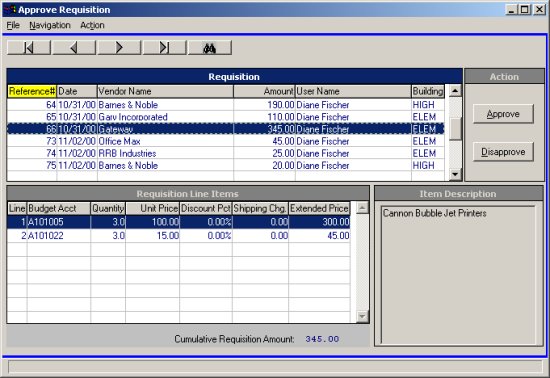
Requisition Browser
The Requisition browser at the top of the window displays those requisitions that are pending approval or disapproval. The information in the browser can be sorted in any of the following ways:
numerically by requisition reference number,
from earliest to most recent requisition date,
alphabetically by vendor name,
from smallest to highest requisition amount,
alphabetically by requisitioner name,
alphabetically by building code.
To change the manner in which information is displayed in the browser, simply click on the column title (Reference #, Date, Vendor Name, Amount, User Name, or Building). The column title is highlighted in yellow to indicate the selected sort option. Use this browser to select the appropriate requisition record.
Requisition Line Items
Based on the record selected in the Requisition browser, the system displays the associated detail requisition line items on the bottom left-hand side of the window. The detail record includes the following information: number of line items in the requisition, account number to which the item is being expensed, quantity ordered, unit price per unit of measurement ordered, discount percent, shipping charge and extended price. The Cumulative Requisition Amount is also provided. Use this browser to select and view a specific requisition line item.
Item Description
Based on the record selected in the Requisition Line Items browser, the system displays the detailed item description as entered during the Requisition Entry process.
Drop-Down Menus
The following drop-down menus are displayed on the window:
File This menu provides access to the Exit option that allows you to exit the function.
Navigation This menu provides access to the First, Previous, Next, Last, and Search options that allow you to locate specific records in the browser.
Action This menu provides access to the Approve and Disapprove functions.
The navigation options can be accessed through the buttons at the top of the window or through the Navigation drop-down menu.
| Navigation Button |
Function |
| First |
This option is used to highlight the first record in the browser. |
| Previous |
This option is used to highlight the previous record in the browser. For example, if there are five records in the browser and your cursor is highlighting the third record, select the Previous button to highlight the previous (second) record. |
| Next |
This option is used to highlight the next record in the browser. For example, if there are five records in the browser and your cursor is highlighting the third record, select the Next button to highlight the next (fourth) record. |
Last
|
This option is used to highlight the last record in the browser. |
| Search |
Based on the sort method selected, this option is used to search for a specific record. Select this option to display the Search field. Depending on the sort selection, key in one or more characters/numbers and press Enter or Tab to exit the search field. The system highlights the requisition record or the closest match to your entry. |
| Action Button |
Function |
| Approve | This option is used to approve a selected requisition.
1. Select the appropriate requisition record from the Requisition browser. 2. Press the Approve button.
The requisition is removed from the browser and is sent to either the next approver or the Business Office for approval. At this point, the record is also removed from the requisitioner’s requisition listing. If the Business Office is approving the requisition, the requisition is ready to be converted to a purchase order. |
| Disapprove | This option is used to disapprove a selected requisition.
1. Select the appropriate requisition record from the Requisition browser. 2. Press the Disapprove button. 3. The following pop-up window displays for you to indicate the reason that requisition is being disapproved. |
Approve Requisitions
To access the Approve Requisitions function, select the Level Three option from the Approval Process drop-down menu or simply select the Level 3 button on the Requisition Manager main window. The Level 3 button is active based on the authorization level defined for the approver in the Setup Approval Process Parameters function. In addition, the "RQ – Approval Level" permissions defined for the user in User Maintenance must also be set to YES.
Use the Approve Requisition function to approve or disapprove those requisitions that are currently in a Pending status.
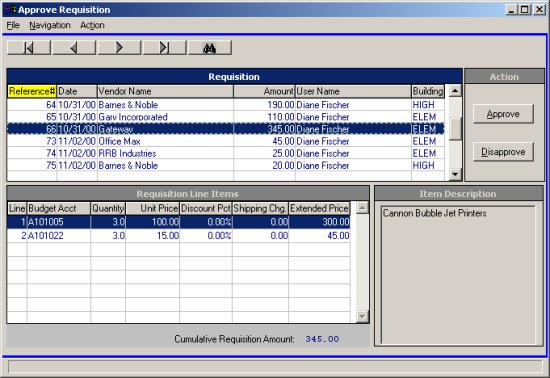
Requisition Browser
The Requisition browser at the top of the window displays those requisitions that are pending approval or disapproval. The information in the browser can be sorted in any of the following ways:
numerically by requisition reference number,
from earliest to most recent requisition date,
alphabetically by vendor name,
from smallest to highest requisition amount,
alphabetically by requisitioner name,
alphabetically by building code.
To change the manner in which information is displayed in the browser, simply click on the column title (Reference #, Date, Vendor Name, Amount, User Name, or Building). The column title is highlighted in yellow to indicate the selected sort option. Use this browser to select the appropriate requisition record.
Requisition Line Items
Based on the record selected in the Requisition browser, the system displays the associated detail requisition line items on the bottom left-hand side of the window. The detail record includes the following information: number of line items in the requisition, account number to which the item is being expensed, quantity ordered, unit price per unit of measurement ordered, discount percent, shipping charge and extended price. The Cumulative Requisition Amount is also provided. Use this browser to select and view a specific requisition line item.
Item Description
Based on the record selected in the Requisition Line Items browser, the system displays the detailed item description as entered during the Requisition Entry process.
Drop-Down Menus
The following drop-down menus are displayed on the window:
File This menu provides access to the Exit option that allows you to exit the function.
Navigation This menu provides access to the First, Previous, Next, Last, and Search options that allow you to locate specific records in the browser.
Action This menu provides access to the Approve and Disapprove functions.
The navigation options can be accessed through the buttons at the top of the window or through the Navigation drop-down menu.
| Navigation Button |
Function |
| First |
This option is used to highlight the first record in the browser. |
| Previous |
This option is used to highlight the previous record in the browser. For example, if there are five records in the browser and your cursor is highlighting the third record, select the Previous button to highlight the previous (second) record. |
| Next |
This option is used to highlight the next record in the browser. For example, if there are five records in the browser and your cursor is highlighting the third record, select the Next button to highlight the next (fourth) record. |
Last
|
This option is used to highlight the last record in the browser. |
| Search |
Based on the sort method selected, this option is used to search for a specific record. Select this option to display the Search field. Depending on the sort selection, key in one or more characters/numbers and press Enter or Tab to exit the search field. The system highlights the requisition record or the closest match to your entry. |
| Action Button |
Function |
| Approve | This option is used to approve a selected requisition.
1. Select the appropriate requisition record from the Requisition browser. 2. Press the Approve button.
The requisition is removed from the browser and is sent to either the next approver or the Business Office for approval. At this point, the record is also removed from the requisitioner’s requisition listing. If the Business Office is approving the requisition, the requisition is ready to be converted to a purchase order. |
| Disapprove | This option is used to disapprove a selected requisition.
1. Select the appropriate requisition record from the Requisition browser. 2. Press the Disapprove button. 3. The following pop-up window displays for you to indicate the reason that requisition is being disapproved. |
Approve Requisitions
To access the Approve Requisitions function, select the Business Office option from the Approval Process drop-down menu or simply select the Bus Appr button on the Requisition Manager main window. The Bus Appr button is active based on the authorization level defined for the approver in the Setup Approval Process Parameters function. In addition, the "RQ – Business Office" permissions defined for the user in User Maintenance must also be set to YES.
Use the Approve Requisition function to approve or disapprove those requisitions that are currently in a Pending status.

Requisition Browser
The Requisition browser at the top of the window displays those requisitions that are pending approval or disapproval. The information in the browser can be sorted in any of the following ways:
numerically by requisition reference number,
from earliest to most recent requisition date,
alphabetically by vendor name,
from smallest to highest requisition amount,
alphabetically by requisitioner name,
alphabetically by building code.
To change the manner in which information is displayed in the browser, simply click on the column title (Reference #, Date, Vendor Name, Amount, User Name, or Building). The column title is highlighted in yellow to indicate the selected sort option. Use this browser to select the appropriate requisition record.
Requisition Line Items
Based on the record selected in the Requisition browser, the system displays the associated detail requisition line items on the bottom left-hand side of the window. The detail record includes the following information: number of line items in the requisition, account number to which the item is being expensed, quantity ordered, unit price per unit of measurement ordered, discount percent, shipping charge and extended price. The Cumulative Requisition Amount is also provided. Use this browser to select and view a specific requisition line item.
Item Description
Based on the record selected in the Requisition Line Items browser, the system displays the detailed item description as entered during the Requisition Entry process.
Drop-Down Menus
The following drop-down menus are displayed on the window:
File This menu provides access to the Exit option that allows you to exit the function.
Navigation This menu provides access to the First, Previous, Next, Last, and Search options that allow you to locate specific records in the browser.
Action This menu provides access to the Approve and Disapprove functions.
The navigation options can be accessed through the buttons at the top of the window or through the Navigation drop-down menu.
| Navigation Button |
Function |
| First |
This option is used to highlight the first record in the browser. |
| Previous |
This option is used to highlight the previous record in the browser. For example, if there are five records in the browser and your cursor is highlighting the third record, select the Previous button to highlight the previous (second) record. |
| Next |
This option is used to highlight the next record in the browser. For example, if there are five records in the browser and your cursor is highlighting the third record, select the Next button to highlight the next (fourth) record. |
Last
|
This option is used to highlight the last record in the browser. |
| Search |
Based on the sort method selected, this option is used to search for a specific record. Select this option to display the Search field. Depending on the sort selection, key in one or more characters/numbers and press Enter or Tab to exit the search field. The system highlights the requisition record or the closest match to your entry. |
| Action Button |
Function |
| Approve | This option is used to approve a selected requisition.
1. Select the appropriate requisition record from the Requisition browser. 2. Press the Approve button.
The requisition is removed from the browser and is sent to either the next approver or the Business Office for approval. At this point, the record is also removed from the requisitioner’s requisition listing. If the Business Office is approving the requisition, the requisition is ready to be converted to a purchase order. |
| Disapprove | This option is used to disapprove a selected requisition.
1. Select the appropriate requisition record from the Requisition browser. 2. Press the Disapprove button. 3. The following pop-up window displays for you to indicate the reason that requisition is being disapproved. |
To access the Create Purchase Order from Requisition function, select the Create Purchase Order option from the Approval Process drop-down menu or simply select the Create PO button on the Requisition Manager main window.
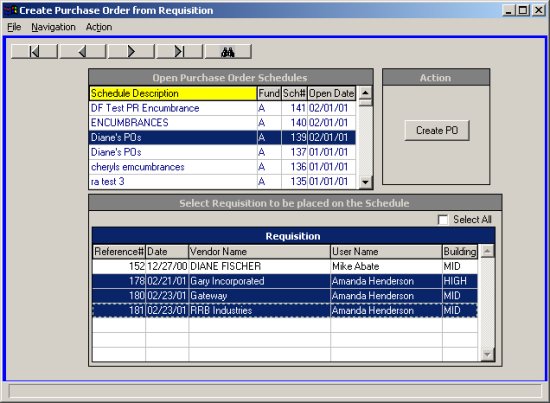
This option is used to choose an open schedule to which you want to place selected requisitions. The requisitions will then be converted into purchase orders.
Open Purchase Order Schedule Browser
The browser at the top of the window displays those purchase order schedules that are currently open. The information in the browser can be sorted in any of the following ways:
alphabetically by schedule description,
alphabetically by fund,
in numerical ascending order by schedule number,
from oldest to most recent schedule date.
To change the manner in which information is displayed in the browser, simply click on the column title (Schedule Description, Fund, Sch#, or Open Date). The column title is highlighted in yellow to indicate the selected sort option. Use this browser to select the appropriate schedule record.
Requisitions
The browser at the bottom of the window displays those requisitions that have been approved by the Business Office and are ready to be converted to purchase orders. The requisition record includes the following information: reference number, requisition date, vendor name, requisitioner’s name, and building. Use this browser to choose those requisitions that are to be placed on the selected schedule.
Drop-Down Menus
The following drop-down menus are displayed on the window:
File This menu provides access to the Exit option that allows you to exit the function.
Navigation This menu provides access to the First, Previous, Next, Last, and Search options that allow you to locate specific records in the Open Purchase Order Schedule browser.
Action This menu provides access to the Create PO function.
The navigation options can be accessed through the buttons at the top of the window or through the Navigation drop-down menu.
| Navigation Button |
Function |
| First |
This option is used to highlight the first record in the Open Purchase Order Schedule browser. |
| Previous |
This option is used to highlight the previous record in the Open Purchase Order Schedule browser. For example, if there are five records in the browser and your cursor is highlighting the third record, select the Previous button to highlight the previous (second) record. |
| Next |
This option is used to highlight the next record in the Open Purchase Order Schedule browser. For example, if there are five records in the browser and your cursor is highlighting the third record, select the Next button to highlight the next (fourth) record. |
Last
|
This option is used to highlight the last record in the Open Purchase Order Schedule browser. |
| Search |
Based on the sort method selected, this option is used to search for a specific purchase order schedule record. Select this option to display the Search field. Depending on the sort selection, key in one or more characters/numbers and press Enter or Tab to exit the search field. The system highlights the schedule record or the closest match to your entry. |
| Action Button |
Function |
| Create PO | This option is used to select those requisitions that are to be converted to purchase orders.
1. Select the appropriate schedule record from the Open Purchase Order Schedules browser. NOTE: When selecting a schedule, the date of the requisition must fall within the date range of the purchase order schedule. For example, you cannot add a November requisition to a schedule with an October date range. 2. Select one or more requisitions to be placed on the selected schedule. Use the Control key and your mouse to select multiple requisitions. |
To access the Account Status Report function, select the Account Status option from the User Routines menu on the Query drop-down menu or button in Requisition Manager.
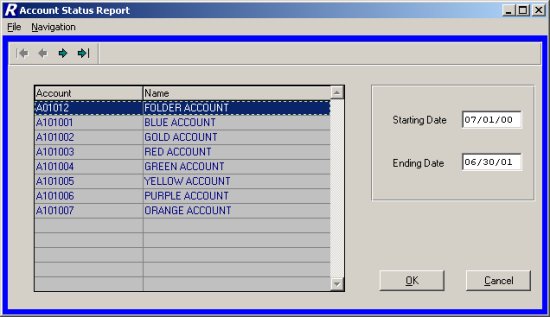
The Account Status Report criteria window displays a listing of those account codes linked to the user as defined in the User Account Chart Links function.
Drop-Down Menus
The following drop-down menus are displayed on the window:
File This menu provides access to the Exit option that allows you to exit the function.
Navigation This menu provides access to the First, Previous, Next, and Last options that allow you to locate specific records in the browser.
The navigation options can be accessed through the buttons at the top of the window or through the Navigation drop-down menu.
| Navigation Button |
Function |
| First |
This option is used to highlight the first record in the browser. |
| Previous |
This option is used to highlight the previous record in the browser. For example, if there are five records in the browser and your cursor is highlighting the third record, select the Previous button to highlight the previous (second) record. |
| Next |
This option is used to highlight the next record in the browser. For example, if there are five records in the browser and your cursor is highlighting the third record, select the Next button to highlight the next (fourth) record. |
Last
|
This option is used to highlight the last record in the browser. |
To Generate the Account Status Report:
1. Select the appropriate account from the browser.
2. Enter the reporting starting and ending date range.
3. Press the OK button.
The Account Status Report displays the selected date range and account. The report provides the following information: opening budget amount, adjustments, adjusted budget amount, encumbrances placed, encumbrances liquidated, outstanding encumbrances, outstanding requisitions, amount expensed, and unencumbered balance. The Unencumbered Balance is determined as follows:
Adjusted Budget – (Outstanding Encumbrances + Outstanding Requisitions + Amount Expensed).
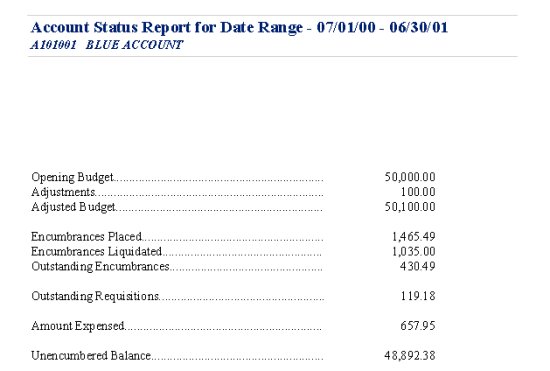
Requisition Approval Maintenance
To access the Requisition Approval Maintenance function, select the Setup Approval Process Parameters option from the Utilities drop-down menu or button in Requisition Manager.
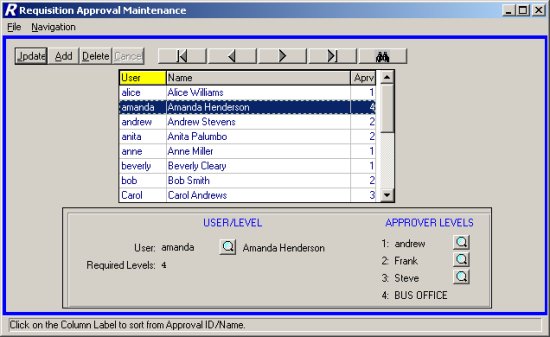
The Requisition Approval Maintenance function is used to define the approval process for each user of FM2000 Requisition Manager. For each user, the above window is utilized to indicate the number of required approval levels and the name of the approver at each level.
The above illustration shows that the selected user, Bob Smith, has two approval levels. After Bob Smith enters a requisition, the requisition must first be approved by Susan and then by the Business Office before it can be converted to a purchase order.
Selecting a Sort Option
The Requisition Approval Maintenance window displays a listing of users of the FM2000 System who currently have an approval process record. The information in the browser can be sorted in one of the following ways:
· in alphabetical order by User ID
· in alphabetical order by User Name
· in numerical ascending order by Approval Level
To change the manner in which information is displayed in the browser, simply click on the column title (User, Name, or Aprv). The column title is highlighted in yellow to indicate the selected sort option. Use this window to select the appropriate user approval record.
Drop-Down Menus
The following drop-down menus are displayed on the window:
File This menu provides access to the Exit option which allows you to exit the function.
Navigation This menu provides access to the First, Previous, Next, Last, and Search options that allow you to locate specific records in the browser based on the sort method selected.
The navigation options can be accessed through the buttons at the top of the window or through the Navigation drop-down menu.
| Navigation Button |
Function |
| First |
Based on the sort method selected, this option is used to highlight the first record in the browser. |
| Previous |
Based on the sort method selected, this option is used to highlight the previous record in the browser. For example, if there are five records in the browser and your cursor is highlighting the third record, select the Previous button to highlight the previous (second) record. |
| Next |
Based on the sort method selected, this option is used to highlight the next record in the browser. For example, if there are five records in the browser and your cursor is highlighting the third record, select the Next button to highlight the next (fourth) record. |
Last |
Based on the sort method selected, this option is used to highlight the last record in the browser. |
| Search |
Based on the sort method selected, this option is used to search for a specific record. Select this option to display the Search field. Depending on the sort selection, key in one or more characters and press Enter or Tab to exit the search field. The system highlights the closest match to the characters entered. |
Use this function to add or maintain user approval records.
| Field | Description |
| User | The ID of the user with whom this approval record is associated. Use the lookup button to display and choose from a listing of all users of the FM2000 System who have a security record. |
| Required Levels | Enter the number of required approval levels for this user. Valid entries are 1 through 4.
1 – The requisition only needs the approval of the Business Office. 2 – The requisition must first be approved by one other user and then must be approved by the Business Office. 3 – The requisition must first be approved by two different users and then must be approved by the Business Office. 4 – The requisition must first be approved by three different users and then must be approved by the Business Office. |
| Approver Levels | The Level number and ID of the individual who is to approve requisitions for this user. Use the lookup button to display and choose from a listing of those FM2000 users who have a security record where the Requisition Approver field is set to YES in User Maintenance. |
Adding a User Approval Record
· Select the Add button.
· Enter the user ID, required level, and approvers for the user.
· Press Save to lock in the new information.
Updating a User Approval Record
· Highlight the appropriate user approval record in the browser. The navigation button options and/or browser scroll bar will assist you in finding the desired record.
· Select the Update button.
· Modify the required level and approvers for the user.
· Press Save to lock in the new information.
Deleting a User Approval Record
· Highlight the appropriate user approval record in the browser. The navigation button options and/or browser scroll bar will assist you in finding the desired record.
· Select the Delete button.
·
The system prompts you to confirm that this is the correct action that you wish to take.
Choose YES to delete the user’s approval record.
Choose NO if you do not wish to delete the user’s approval record.
Index
A
Account Status 54, 55
Appropriation Status 58
B
Business Office 47, 49
C
Create Purchase Orders 51
Custom Menu 61
D
Document Flow 7
E
Encumbrances 8
Enter Requisitions 10
I
Individual Account Tranactions 60
Item Entry 15, 18, 27, 30
L
Level One 35
Level Three 43
Level Two 39
M
Modules 67
O
Overview 6
P
Percent Distribution 21, 33
Q
Query a Requisition 59
R
Requisition Status 56
Requisitions 62
Resubmit Requisitions 23
S
Set up Approval Process Parameters 63
Shipping 19, 31
Status Listing 57
W
What is a Requisition? 9
1